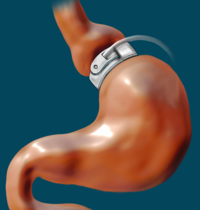
Photo from wikipedia
The evaluation of the tone and contractile patterns of the gastrointestinal (GI) tract via manometry is essential for the diagnosis of GI motility disorders. However, manometry is expensive and relies… Click to show full abstract
The evaluation of the tone and contractile patterns of the gastrointestinal (GI) tract via manometry is essential for the diagnosis of GI motility disorders. However, manometry is expensive and relies on complex and bulky instrumentation. Here we report the development and performance of an inexpensive and easy-to-manufacture catheter-like device for capturing manometric data across the dynamic range observed in the human GI tract. The device, which we designed to resemble the quipu-knotted strings used by Andean civilizations for the capture and transmission of information-consists of knotted piezoresistive pressure sensors made by infusing a liquid metal (eutectic gallium-indium) through thin silicone tubing. By exploring a range of knotting configurations, we identified optimal design schemes that led to sensing performances comparable to those of commercial devices for GI manometry, as we show for the sensing of GI motility in multiple anatomic sites of the GI tract of anaesthetized pigs. Disposable and customizable piezoresistive catheters may broaden the use of GI manometry in low-resource settings.
Journal Title: Nature biomedical engineering
Year Published: 2022
Link to full text (if available)
Share on Social Media: Sign Up to like & get
recommendations!